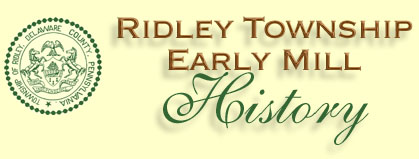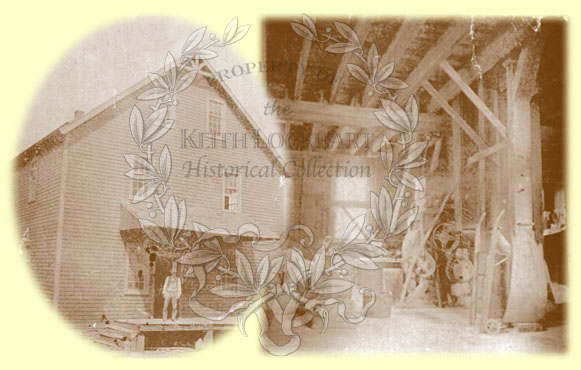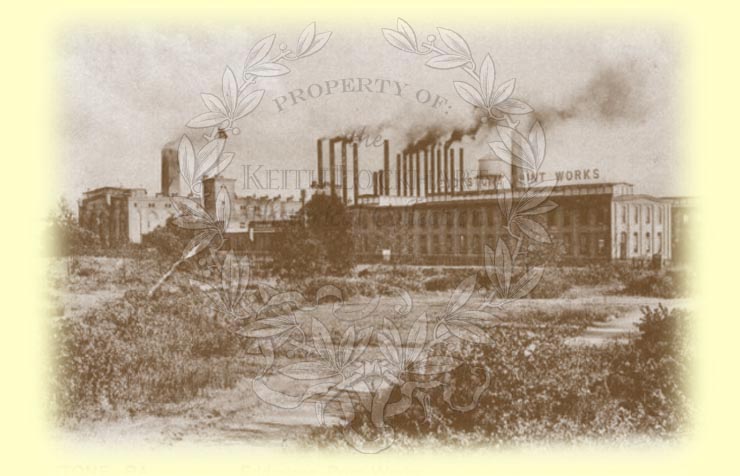1765 | 1766 | 1767 | 1768 | 1769 | 1771 | 1774 | 1779 | 1780 | 1781 | 1785
Lapidea, Phipps Mills | Harvey-Lewis Mill | Crosby-Carter, Forge Leiperville Mills | Hill-Hickman Mill | East Morton | Eddystone Print Works
~ Welcome ~
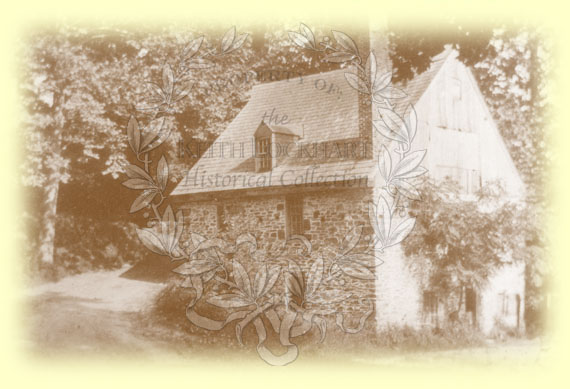
The Photo Above: The Glenolden Mill was built about 1755 by Thomas Shipley, and stood in what is now Folcroft Boro at Delmar Driveand South Ave. The road in the Picture above is Today's Delmar Dr. The Mill dam can still be seen just above Delmar Drive. In the early part of the 19th century the mill can into the hands of Ephriam Inskeep and later his son, William Ridgeway. Ridgeway named the mill "Glen Olden", Olden for his mothers maiden name and the Glen for the area along the Mucinapatus Creek. The Glenolden Mill burned to the ground in February 1896.
1766
John Lewis, saw mill. 200
John, Mucklewayne,{ McIlvain} grist mill. 110
1767
Jno. Lewis, saw mill. 250
John McLlwayne {McIlvain}, grist mill 108
Caleb Phipps, grist mill 13
1768
Jno. Lewis, saw mill. 300
Hugh Lloyd, grist mill, miller -
Caleb Phipps, grist mill, miller 13
1769
Caleb Phipps, grist mill, miller 12
Harvey Lewis, saw mill. 300
Hugh Lloyd, grist mill, miller -
1771
Hugh Lloyd, grist mill, dealer in flower 6
Caleb Phipps, grist mill 13
1779
Isaac Eyres, mill 27
Jas. Hannum, mill 9
1780
Isaac Eyres, mill 27
James Hannum, mill 9
1781
Isaac Eyers, grist mill 27
Isaac McIlvain, grist mill 8
Lewis Tremble, saw mill. 322
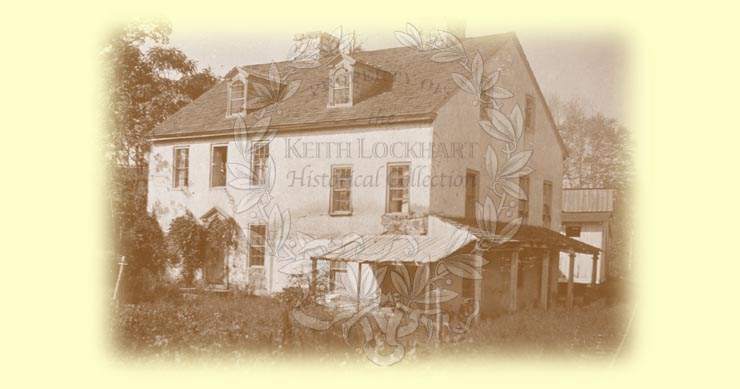
The Photo Above: This rare photo is of the George Leiper home in the late 1890's. The house was torn down100 years ago. The house stood about 100 yards north of Bullen's Lane just east of the Blue Route. George Leiper (1786-1868) operated both the Leiper Quarries and the Mills. The last of the Quarries ceased operations in the 1940's. The Leiper Family built the first railroad in Pennsylvania and the Leiper Canal to help move stone from their Quarries.
#1 Lapidea Mills, Phipps Mills Crum Creek
This mill was built by Joseph Phipps in 1762 on property purchased from John Crosby. Joseph Phipps, miller of Uwclan Twp. Chester County. sold {Ches. Co. DeedP-530} the mill property to his son, Caleb on July 29,1769. The sale included a house, tenements and grist mill in Ridley and a total of three tracts of land for 917 lbs. Tract #1= mill 12 acres and 18 perches; Tract #2- 4 acres and Tract #3- 2 acres. On February 8,1774 Caleb and Susan Phipps sold{N-220} 16 acres with the grist mill. The buyer at 1650 lbs. was Isaac Eyre, tanner, of Chester. The mill was described as 45 by 40 feet, three stories high. Eyre on May 11,1785 sold {Deed Z-105} a half share in the mill property to Richard Flower of Ridley. In 1790 George Pearson was the miller for Flower. Flower sold{ Deed C-11} his half share to John Wall on June 23,1793.Wall, a Philadelphia Merchant, and his wife Hannah, sold{P-306} the mill and three tracts to Thomas Leiper for $8,500.00.
In 1808 Leiper was taxed for a Grist and Saw mill and In 1816 he erected the present "Lapidea Mill" which his son George Leiper operated. In 1821 John P. Crozer purchased the machinery of a small cotton mill and rented the second and third floor and part of the first of the Leiper Grist Mill and commenced work in February of 1822. The cost was $600.00 and included five tenements. Crozer originally spun yarn but later weaved cotton. Crozer left the Leiper Mill and moved to Aston in 1825 taking over the Mattson Paper Mill. In 1826 Joseph Burt rented the mill as a woolen factory till May of 1841 when Richard Blundin rented and ran both the woolen and grist mills. In 1848 Edward Taylor leased the mill for one year and then Daniel Lees took over. The mill property of 16 acres 29 perches and one road with mill and tenant houses was sold {Deed A3-84} to Samuel Lewis and Samuel P. Crozer on December 27,1869 for $6001.00 by Leiper Executors John Thomas and Edward Farnum.
Harvey-Lewis Mill Stoney Run Creek
In 1708 Joseph Harvey Sr. married Mary Simcock and was given 300 acres in Ridley Township {Folsom}. He built a grist mill about 1722 indicated by the higher tax rate that year. This
mill would have stood in the area of Maan Field in the Park at Fourth and Sutton Aves. By 1744, he also had a malt house and shelling mill. {Pa. Gazette Newspaper}. His only surviving child, Alice married
John Lewis who received the Harvey estate at Harvey's death in early 1756?. On May 1, 1773 John and Alice Lewis, yeoman of Haverford sold {Deed S-434} for 20 shillings and "love and affection"
123 acres to his son Harvey Lewis of Ridley. On the property were Jones and Lewis's Mills and dam on Stoney Run Creek with a shelling mill and malt house. Harvey Lewis died about October of 1796 and
the property of 120 acres passed to his eldest son Curtis. Curtis sold the property to John Nicholson. Nicholson was a land speculator and fell heavy into debt. Delco
Sheriff Abraham Dicks, on September 9,1797 sold{D-119} the below property with saw mill to Standish Ford for $5,000.00 in silver. The property had belonged to John Nicholson who owed various parties
$16,000.00. On February 18, 1799 Standish and Sarah Ford, a Philadelphia Merchant sold{D-437} for $8,000.00 "a Ridley Plantation and saw mill" of 270 acres to John Conchy, Philadelphia Merchant.
Shortly After the sale the saw mill was closed.
Crosby-Carter mill and forge Leiperville Mills Crum Creek
On November 12,1717 John Crosby, Ridley Twp. yeoman sold{D2-120} 50 acres on the east side of Crum Creek to James Bollen, "late of Philadelphia Gent". The price was 350 lbs. of which Bollen
borrowed 250 from Crosby. The property included a house, "mill and mills". These mills were a grist and saw mill. Two bolting mills were in the grist mill. The mills would have stood south
of Chester Pike about 700 feet on the east side of Crum Creek on the property that later became the Baldwin Locomotive Works.
Bollen or Bullen failed on his mortgage with Crosby and in late 1743, John Crosby sold the above property and more for a total of 103 acres to Joseph Carter "of Ridley, miller". Carter sold two-thirds of the same property to his two sons; Joseph Jr. and John in December of 1743. The Carters and Crosby also went into a partnership for a forge on the Carter property. An agreement was signed on December 24, 1740. Joseph and Jacob Carter borrowed 520 lbs. from Joseph Parker of Chester on April 2, 1750. The mortgage was secured on their 110 acres with "water corn mill or grist mill, saw mill and Iron forge". It is believed this mortgage was never satisfied. Peter Kalm the Swedish naturalist mentions this forge in his book on travels. This forge appears to be the "Kingsherry" that the Carters mention on March 5, 1751 when they advertised for a runaway. The terms of the agreement are unknown but on February 5, 1751 the Penna. Gazette advertised the Forge formerly of John Crosby Esq. for rent or sale in Ridley Township with 100 acres. The Carters in the same paper on June 4, 1752 advertised one half of a grist and saw mill for sale with half of 50 acres.
The Carters sold their property to John Houlton who sold it John McIlvain see mortgages.
Tax records for 1766 and 1767 show a grist mill owned by John McIlvain.
On January 2, 1792 Isaac and Susannah McIlvain, a Philadelphia house carpenter, sold{D-399} their one fourth part of 9 equal 11 parts for 500 lbs. The buyer was Thomas Leiper, Philadelphia Tobacconist. The property included a "water corn and grist mill" on 5 and a quarter acres and 20 perches on a "small run". Elizabeth Leiper, widow of Thomas and sons William, Philadelphia merchant and George and Elizabeth Leiper of Delco on March 8,1822 sold{R-107} their one fourth part to Jeremiah McIlvain of Ridley for $3,000.00. The property was 5 and a quarter acres and 20 perches with a grist mill on Crum Creek.
In 1826 Leiper had a grist, saw mill and woolen factory here known as "Leiperville Mills". About 1845 George Leiper built a new factory on Crum Creek in Leiperville and leased it to James Campbell by 1850. Saw and Tilt mills are for rent in Leiperville in the newspaper of April 15, 1853. Lately occupied by Robert Beatty as an edge tool factory. Apply to James Campbell. Campbell left the property in 1858 and Leiper leased the property in May to Michael Buggy who made woolen jeans at the "Leiperville Factory". Buggy leased the mill till at least 1868.
This mill, part of the George Leiper Estate was sold{Y2-247} by executors, John Thomas and Edward Farnum on August 2,1869 to Daniel Lees of Chester. The 24 acres, 34 perches and three roads included a cotton factory and house near "Leiper's Landing" on Crum Creek. The cost was $8,253.00.
The mill burned down in on February 19, 1878. There were two mills on the property the older one paralleled Chester Pike and was two and a half stories the newer one three and a half stories high. Both buildings were destroyed estimated loss was $35,000.00.{Chester Times.2-20-1878.} The mill was rebuilt and reopened in May 1881. In March of 1881 Oliver Holt formed a partnership with Daniel Lees to manufacture cotton and wool goods. {Morton Chronicle.3-3-1881}
Since Lees & Holt commenced operating their mill at Leiperville, a few months ago, sixteen families have moved to that place. {M. C. June 2, 1881} After this fire Lees took Oliver Holt as a partner. {M.C.10-20-1881}. On Saturday October 15, 1881 the mill was destroyed by fire. At the time of the fire, the mill contain 30 looms and made cotton jeans. The damage was about $25,000. The mills were rebuilt, a two story stone building 130 by 160 was erected with a brick one story addition 149 by 140 feet.
Lees sold{K3-372} "two undivided third parts" of the property on July 21,1883 to Frank J. Taylor and Oliver Holt both of Ridley for $7,000.00. The property consisted of a "certain mill" and several houses on 20 acres 39 perches and three roads. In April of 1884{C.T. 4-10-1884}the firm of Holt & Taylor built a one story stone engine house.
Morton Chronicle Newspaper April 22,1886
Manufacturers Fail
Holt & Taylor, manufacturers, at Leiperville, failed last week. At a meeting of creditors it was stated the $39,000 of the insolvent firm's debts were in open accounts and $44,000 were secured by judgment notes.
The property of Holt and Taylor was assigned to William Blakley etal. They sold{C6-94} the property to Edward Greene of Philadelphia on June 30,1886. Greene sold{C6-353} the same property to the Crum Lynne Worsted Co. on September 1,1886 for $43,000.00. The property consisted of 24 acres 34 perches and three roads. Including a mill, fixtures, stone store, 7 stone and 5 frame and 2 brick dwellings. On March 3,1890 the Crum Lynne Worsted Co. sold{O7-59} the property to Thomas Lee of Philadelphia for $38,000.00.
The firm of Lee and Longbottom was formed and began business on December 1,1890. The company was known as "Fairview Worsted Mills". {M. C. July 28, 1892}
The mill was sold{W4-390} by Sheriff Elwood Carr due to a mortgage held by Michael Dallett of $8,500.00. A auction was held on April 28,1894 and the property and "mills" was sold for $29,600.00. The buyers were Smith Longbottom and Benjamin Lobley. The firm ran into financial trouble and on June 1, 1896 the firm was placed{K9-394} in the hands of receiver George B. Lindsey. A woolen and worsted mills were present on 24 acres, three roads and 34 perches. On December 9,1896 Sheriff David McClure sold{A13-120} the same property for $150.00 back to Smith Longbottom.
The mills were taken over by the Chester National Bank in 1905 who leased the building to a Henry Jones of Philadelphia. Jones opened the mill as the Kennebec Worsted Mills till Wednesday April 25,1906 when the mill was destroyed by fire. The loss was estimated at $35,000.00. The mills were never rebuilt. The fire was started by oil set on fire by a boy, that got in the mill race .{Chester Times.4-25-1906}
The Picture above is of the Hickman Mill or Ridley Mill which still stands in the 100 Block of todays Haverford Road in Milmont Park. At the time these pictures were taken Thomas Broomall was the Miller, c.1900.
Hill- Hickman Mill on Haverford Road, Milmont
This grist and saw mills were built by Peter Hill Sr. in 1790 and 1791. Despite the stories, it appears Hill never owned any mills during the Revolution. Hill was taxed for 300 acres in 1790 and in
1791 and the mills were first mentioned at that time. Peter Hill Sr. was never taxed for any mill prior to 1790. Hill died in 1814 and the mills were passed to Peter Hill Jr. Peter Jr. and Hannah Hill
gave a deed of assignment to James Copper, Coleman Sellers and Albert Paxson on November 28,1829. This order was to manage or sell property the Hill's owned in Ridley Township left to them by Peter
Hill Sr. On December 13, 1832 the trustees sold{S-404} 12 acres and 46 perches to Henry Burt of Philadelphia. On the property was a house and "Grist Mill now a Cotton Factory".
Per a court order issued on October 28, 1842 Sheriff John Larkin held a public auction of the property of Henry Burt of Ridley on January 28, 1843. The sale mentions 4 frame tenements and a two story cotton factory 50 X 38 feet. The high bidder at $4,860.00 was Henry Effinger for the house, Grist Mill and 12 acres and 46 perches. The 1848 Ash Map shows the tenement houses along Haverford Rd. by the "factory". In December, 1851 Effinger advertised the factory and 8 dwelling houses for rent and also in March of 1852.
In January of 1853 he advertised the property for sale. Henry Effinger of Ridley on May 4,1854 sold{B2-757} a house and Cotton Factory to John Bartow of Philadelphia for $3,450.00. The factory stood on 5 acres and 28 perches next to Little Crum Creek. On November 26, 1861 Sheriff Norris Yarnall sold{B2-240} the property of John Barton at auction. Barton owed $3,477.00. and the court decreed on August 31,1861 that the property of 5 acres and 28 perches with the house and cotton factory be sold. The buyer at $5,000.00 was Henry Effinger.
The mill was being rented by James Lord thru Ellen Barton. On June 9, 1863 Effinger sold{K2-648} the house and mill and three acres 30 perches and three roads to Cadwalader Evans of Chester for $2,400.00. Evans sold{M2-258} the same property plus 47 perches to Samuel Hickman of Lower Chichester for $4,375.00. This grist mill was on Little Crum Creek. The 1870 atlas shows a saw mill on the property. In 1881, George Broomall was miller at Hickman's Mill. In April of 1887 Samuel Hickman himself was running the mill. {Morton Chronicle Newspaper.4-7-1887}
In December of 1887 a Albert Wilfong took over the Ridley Flour Mill. He advertised flour and feed for sale.{M.C.12-8-1887} May 8, 1890 Samuel Hickman is having one of his houses at the old mill, near Ridley station, enlarged and improved, and will remove from Linwood to it about June 1st.
On July 4,1891 Hickman's Mill was destroyed by fire. The fire was believed to be arson.{M.C.7-9-1891}. The mill was being rented by a B. Hutchinson at the time of the fire. The mill reopened in late January of 1892 with "J. T. Noyes rollers" instead of burrs. {Morton Chronicle 1-28-1892}
On June 6,1894 Sheriff Ellwood T. Carr sold{A7-356} the mill property of 3 acres and 58 perches to pay a debt of $3,348.00 that Hickman owed. The property was sold at auction on May 31,1894 the high bidder was John C. Tulloch of Moores at $3,525.00.
The Hickman Roller Grist Mill, near Ridley Park, which was purchased recently at sheriff sale by J.C. Tulloch, of Moore, is offered for rent.{Morton Chronicle April 26, 1894}
Thomas Broomall has rented the Hickman grist mill, near Ridley Park. Tom is thoroughly familiar with the business and has a wide acquaintance with the farmers in the surrounding country, and will be glad to have them call upon him when they want their corn and wheat ground. {M.C.July,12,1894}
A new engine is being put in the Ridley mills, near this borough, for grist grinding. {M. C. 12-21-99}
Hickman later was employed at the Green Bank Mills in Delaware were he suffered a heart attack. He died on October 4,1898 at age 63. This mill was last used about 1917, when miller Thomas Broomall died. The mill was made into a twin home which still stands.
East Morton
The Arthur Burns and Worrell steam grist mill. Opened in February of 1883.
The mill was a two story 30 X 60 feet. The mill ground corn and was also a
saw mill. Burns bought mill property in late 1882 and had a mill built.
For Sale - Steam Grist and Saw Mill, office, siding, stable and three acres of ground, in Morton. Eligible located and equipped with every facility for conducting the coal, lumber and feed business. Apply to E. W. SMITH, Morton, PA {M. C. May 14,1885}
The steam grist mill of Parker & Jones, Morton, is running daily. Farmers are invited to bring their grists to this mill, where the steam roller process, with three reductions, can be seen in full operation. {M. C. October 18, 1894}
The Leiper and Lewis Quarries were located at Chester Pike and Bullens Lane. Today{1998} the quarries are filled in and covered with dirt.
Eddystone Print Works
A few days ago our reporter paid a visit to the Eddystone Print Works, and
was kindly shown through by Superintendent Chas. E. Wild. A vast amount of
improvement has been made in the Works within the last few months. The work
in progress noticeable on the outside by a passer-by, gives but a faint idea
of that being done within. An extension is being made to the upright boiler
house, and two large boilers are being set up there. They are 1500 horse power
in the aggregate, and measure five feet by fourteen each. The work is being
done by Edward Ebans. AS new set of drying cans have been placed in position
in the white drying room, which increases the drying capacity one-third. A
new hydraulic strainer is in service in the color shop. Heretofore there was
but one strainer in use so that the straining capacity has been doubled. There
are also six new color kettles, giving one-third more capacity for coloring.
Tow new folding machines have been added. Five engines in different parts
of the Works have been taken out and replaced by engines of greater capacity,
to furnish the necessary additional power. A couple of huge boilers have been
placed under the print room for heating the hanging garrets. The boilers are
seven by twenty-two. A new fireproof room has been build in the he Works for
the storage of copper rollers and "mills". These are very valuable,
and if destroyed could not be replaced for several years. Above this room
the offices of the Works will be built. They will be very fine when finished.
At present the Works are running to their utmost capacity. Many of the departments
are kept in operation day and night. Last week 1,404,048 years were shipped.
About 530 persons are employed in these Works. Improvements are continuing.
Numerous other minor improvements, than those mentioned above, have been made
recently. September 23, 1877 {Delco Advocate}
|
|
|||||||
|
|
|||||||
|
|
~ Site Map ~
